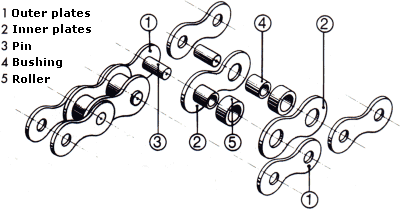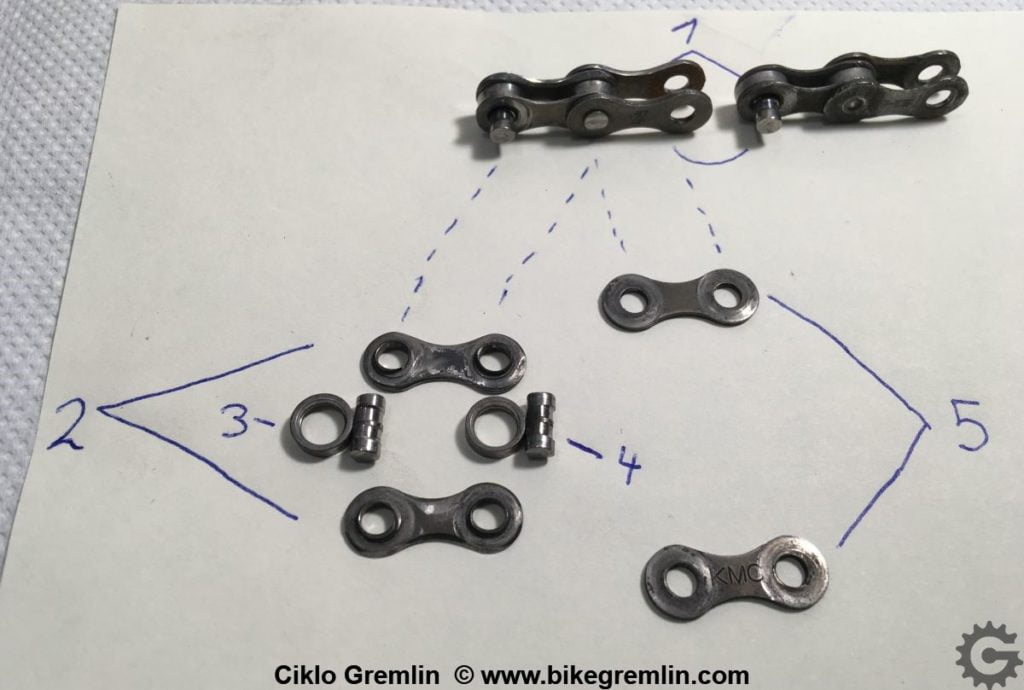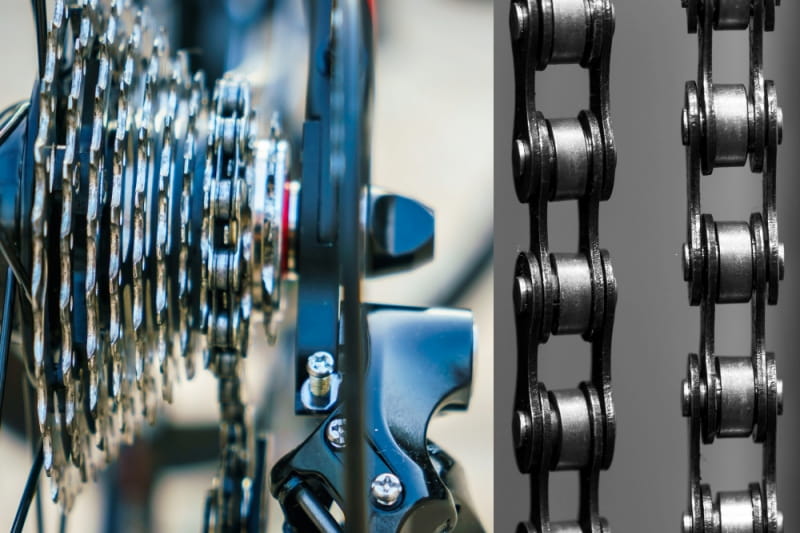Which bicycle transmission chain is the most durable? Does it pay off to buy more expensive chains? Do narrower chains for more speeds wear faster? That’s what I was curious about, so I did some testing.
If you have any questions (or additions and corrections), please use the BikeGremlin forum:
www.bikegremlin.net
Table Of Contents (T.O.C.):
- Chain evolution – briefly
1.1. More speeds – more problems - Testing methods
- Cassette durability
- Chain durability
- Conclusion
TL/DR
I was curious to see if the narrower chains for more speeds really last shorter compared to the low-speed wider chains. After years of testing and experimenting, I’ve concluded that it boils down to the quality of a particular model (all else being equal), not the number of speeds.
This article gives my test methodology, results, conclusions, and briefly explains chain construction (along with the pros and cons of having more speeds).
Yes, dirt and a lack of lubrication are what kills chains, so regular cleaning and lubricating is what makes the biggest difference in terms of chain durability.
1. Chain evolution – briefly
The first bicycle transmission chains I came across were for single, then for five speeds. Those chains lasted for years. That was primarily because of their construction, which included bushings – good at keeping the dirt out, and the lubricant in:

Picture 1
The downsides of this chain construction are more weight, more expensive production, and little sideways flexibility. More speeds at the back (and poor gear shifting technique of the average user) required a chain that is more flexible. So this is what we have today – even with single-speed chains:

1: chain link
2: inner plates
3: roller
4: pin
5: outer plates
Picture 2
These chains are more flexible sideways, lighter, and don’t last nearly as long (perfect for marketing and making a profit, I must add). Lubricant gets quickly and easily washed out, while dirt can easily enter between the inner plates and pins, causing wear (acting as a grinding paste).
1.1. More speeds – more problems
Having more speeds, i.e. more rear sprockets, requires the sprockets to be narrower and more tightly packed. Rear hubs did get a bit wider over the years (rear hub width standards), but the number of sprockets went from 5 to 12 (Rotor makes 13-sprockets). Cassettes with narrow and closely spaced sprockets require narrower chains (bicycle chain dimension standards).
Systems with 10 or more rear sprockets are very sensitive to any imperfections. The slightest bend in the rear derailleur hanger, poor quality of housing, and even poor cable and housing routing can cause shifting problems.
But what about chain durability? That’s what this article is about.
2. Testing methods
I’ve been cycling for decades. In addition, I fix bicycles – both my own and the bikes of friends and acquaintances. I’ve also worked in a bicycle shop and ran my own workshop for a few years. This provided me with a lot of feedback and first-hand experience.
In addition to (or in spite of) that, I wanted to make a controlled experiment, as best as I could, and see if it confirms the data I had gathered so far.
That’s why I chose my main commuter bike, with three front and seven rear chainrings, as a testing rig. Because chains for more “speeds” can fit cassettes with fewer chainrings, while vice-versa is not possible.
I ride that bicycle a lot. I don’t expect chainring width to affect chain durability because rollers will distribute any force equally, while roller wear doesn’t affect chain engagement or wear. It’s the wear between the pins and the inner plates that counts.
Throughout the experiment, I used the same chain lubricant (1/5 of diesel mixed with 4/5 of chainsaw bar oil) and the same regime of cleaning and re-lubing the chain. That is, every two weeks, I’d give the chain a wipe with a rag and re-lubricate it. This is a quick & dirty method of chain maintenance. My aim was not to get the maximum life out of every chain but to see how they compare under similar conditions. Which one lasts longer?
I measured chains using a ruler, and once they reached 0.5% elongation, I considered them worn out.
3. Cassette durability
I did not measure and compare cassette durability. Why? Factors affecting cassette wear are challenging to control outside of a laboratory. Some of the things that affect cassette wear are:
- Riding with a chain elongated beyond 0.5% will quickly wear out a cassette.
- Primarily using one or just a few sprockets will wear those sprockets more quickly.
Also, it is very difficult to measure the exact amount of cassette sprocket wear. In practice, wear is determined by a new chain skipping over the (mostly used) sprockets when pedalling under load.
Regardless of the number of speeds, if a chain is replaced at 0.5% elongation, cassettes last about three chain replacements (after 3 to 4 such chain replacements, the cassette starts skipping with a new chain).
So it could be said that chain wear and condition greatly affect cassette wear and durability.
4. Chain durability
Before publishing the test results, a note:
The areas I ride in have a lot of dust, sand and mud, which reduce the chain’s life span. However, I was curious to see how long chains last compared to each other and see which one gives the best bang for the buck.
| Chain model | Durability (km) | Price (EUR) | durability/price (bang for the buck) |
|---|---|---|---|
| KMC Z50 6/7-speed | 2,000 | 5.5 | 363 |
| KMC X-8 Amazon affiliate link 8-speed | 4,500 * | 12.8 | 351 |
| Shimano Ultegra CN-6701 Amazon affiliate link 10-speed | 4,400 * | 27.3 | 161 |
Table 1
* The difference in durability between KMC X-8, and Shimano Ultegra CN-6701 chains is within the margin of measurement error. So, it can be said that, based on my testing and experience, both models last roughly the same.
Despite the non-laboratory testing method and very small sample size, the results align with my experience over the years – both with mine and with other people’s bicycles.
- KMC X series chains (regardless of the number of speeds) are durable but also costly.
- KMC Z series chains are among the cheapest but among the least durable.
- Shimano’s higher-mid-range chains (105, Ultegra, Deore) last roughly as long as the KMC X series chains (regardless of the number of speeds). Depending on the price you get them at, the bang for the buck may vary.
- Lower-end Shimano chains (Sora, Acera and lower) last some 30% shorter than KMX X series chains, but if you get them at a cheap price, they can offer a good bang for the buck.
- SRAM chains of the 30-series are on par with Shimano’s lower-end chains but are often cheaper. I’m talking about models like PC 830 for 8-speeds, PC 1030 and PC 1031 for 10-speeds etc.
- SRAM 50-series is close to the 30-series in terms of durability.
- SRAM 70 and 90 series chains last noticeably longer, beating the KMC X series and on par with the high-end Shimano chain series.
I’m not mentioning chains I don’t work a lot with – the newest 12-speed chains, SRAM flat-top, YBN chains that aren’t locally widely available etc.
5. Conclusion
First, a disclaimer: I’ve used rather rudimentary testing methods, without thousands of samples for any statistically valid data. Even if I had that, I’m not sure how to configure lab tests to simulate gear shifting, rain, mud, sun etc.
The feedback I get from bike shops and friends is not very reliable because chain maintenance significantly affects its lifetime. Make one 10 km climb with a completely dry chain, and it’s worn. It might even break halfway through. Riding conditions are also a big factor. People who ride a lot in the hills, or in mud, will have their chains last a lot shorter compared to flat (paved) road cyclists. So I take most feedback with a bucket of salt.
Having said that, after decades of cycling, thousands of fixed bikes and user feedback, some trends are noticeable.
- Higher-end chains last longer, regardless of the manufacturer and the number of speeds. Depending on the price you pay for them, they may or may not offer a good bang for the buck.
- Chains for more speeds don’t last any shorter compared to fewer-speed chains of the same model – in spite of being narrower.
- Chains for fewer speeds are cheaper than those for more speeds – when comparing similar/same models. So they do give more bang for the buck compared to the chains for more speeds.
Cassette prices should also be considered – the more speeds, the more dollars. - Systems with fewer speeds are more robust and less sensitive to imperfections. Still, their gear shifting is a bit slower – which might make a difference for any competitive cyclists.
For myself, I usually buy mid-range/class chains when they are at a discount. Cheap, low-end chains require frequent replacing, which takes time, so they aren’t worth it, even if they technically give more miles per dollar.
Final note:
Rollers of some chains wear faster. Measuring chain wear with poorly designed tools (which are practically chain-checker tools except for Shimano TL-CN40, TL-CN41, and TL-CN42) gives a false alarm when the chain is only half worn. In a separate article, I’ve explained how to accurately measure chain wear.
If you have any questions (or additions and corrections), please use the BikeGremlin forum:
www.bikegremlin.net


I have started waxing my chains (parafin wax ) as I realise 11 speed will not last as long as 10 speed. Have you tried that?
Chris
Hi Chris,
I am doing a comparative test using wax. Hopefully, by the end of the year, I will have some durability comparison results (at least for my riding style and terrain).
With a bit of luck and good health, I’ll first make a video on bicycle chain waxing and add the longevity results to this article.
For now, I can say that the drivetrain is a bit cleaner, but it also is more of a hassle to keep it lubricated compared to good old oil.
Relja